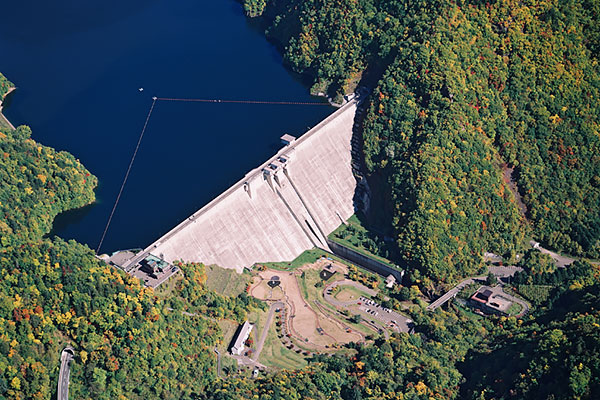
Photograph source:「History of Concrete Dams in Hokkaido」(Association for Civil Engineering Technology of Hokkaido Concrete Research Committee)
| Structure name | Jyozankei DAM |
|---|---|
| Structure type | Gravity concrete dam |
| Purpose | Flood control、Water supply for city water、Hydropowe |
| Structural factors | Height117.5m、Crest length410.0m、Volume1,185×10³m³、Ponding area230ha、Total reservoir capacity82,300×103m³ |
| Operator | Hokkaido Regional Development Bureau Development and Construction |
| Designer | Docon Co.,Ltd |
| Contractor | Taisei Co. 、 Iwata Chizaki Co.,Ltd 、SATO KOGYO Co,ltd |
| Location | Sapporo city |
| River system | Ishikari River/Otarunai River |
| Completion date | 1989 |
| Overview | The Jozankei Dam is the largest gravity concrete dam in Hokkaido, with a bank height of 117.5 meters, a top bank length of 410.0 meters, and a bank volume of 1,185,000 cubic meters. A gravity dam supports the water pressure by the weight of the dam, and is the most popular type of concrete dam. There are a variety of conventional construction methods, including the column block method, layer method, RCD (Roller Compacted Dam-Concrete) method, and the extended layer method. The dam is located in the Lake Shikotsu-Toya National Park. Since there was no established technical method for assessing environmental impact at the time of construction, an Environmental Assessment Committee, consisting of academic experts, was established, and spent four years providing advice, recommendations, and carrying out ecosystem investigations and environmental impact forecasts. Based on these recommendations, three job cranes were used during construction instead of cables cranes, which would have required altering the terrain on the left and right shores. Other natural environmental protection methods included extending the tunnel lengths by 42% to replace the submerged road. Due to the large bank volume, there was concern about cracks due to thermal stress in the concrete. Pipe cooling was carried out to mitigate these effects, along with a column block construction method, which divided the upstream and downstream directions into three blocks. |

